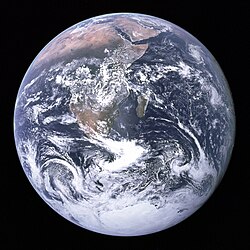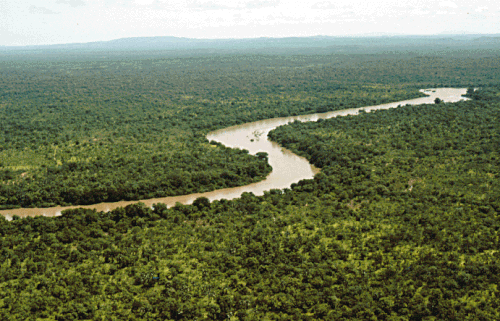Ecology/Introduction
<< Contents page | Chapter 1 | Chapter 2 >>
Chapter 1. Introduction to Basic Ecology

The objective of this wikibook, A Study Guide to Basic Ecology, is to give the reader a better understanding of the way life functions on Earth, and how it is organized. This section will introduce basic concepts and definitions required to establish a course that is both biological and ecological in approach. You will learn that there are numerous terms in ecology which basically mean the same thing, and that there are also a plethora of views on precise definitions. As ecology emerged in the 19th and early 20th centuries, many concepts of ecological organization were proposed. These came from both zoologists and botanists—whom seldom read the other's literature—and from different schools of thought.
Definition of Ecology
[edit | edit source]The term oekologie (ecology) was coined in 1866 by the German biologist, Ernst Haeckel from the Greek oikos meaning "house" or "dwelling", and logos meaning "science" or "study". Thus, ecology is the "study of the household of nature". Haeckel intended it to encompass the study of an animal in relation to both the physical environment and other plants and animals with which it interacted.
A contemporary definition of ecology is:
The scientific study of the distribution and abundance of organisms and the interactions that determine distribution and abundance[1].
This definition encompasses not only the plants and animals that Haeckel recognized but microscopic organisms such as Bacteria, Archaea and protozoa, as well. The interactions that determine an organism's distribution and abundance are processes that include energy flow, growth, reproduction, predation, competition and many others. [2]
Basic Ecology Definitions
[edit | edit source]
To fully understand the science of ecology, there are some common terms that must be defined. The term environment describes, in an unspecified way, the sum total of physical and biotic conditions that influence an organism (Kendeigh, 1961). The subset of the planet earth environment into which life penetrates is termed the biosphere. With respect to the planet earth, the biosphere penetrates only a limited distance into the rock beneath the land and the oceans, and a limited distance out away from the planet towards space. All human effort so far has failed to demonstrate that the biosphere extends beyond these limits or that other biospheres exist elsewhere in the universe. We cannot therefore conclude that they do not exist, only that we know nothing of that existence. Ecosystem is perhaps the most widely used term in ecology. It is defined as the system of organisms and physical factors under study or consideration. Although the boundaries of ecosystems are sometimes quite difficult to define in nature, ecosystems—however bounded—comprise the basic units of that nature (Tansley, 1935). Habitat is generally considered by biologists to be the physical conditions that surround a species, or species population, or assemblage of species, or community (Clements and Shelford, 1939).
The basic physical units of the biosphere are the lithosphere (the land), hydrosphere (the water), and atmosphere (the air). Apparently there is no permanent biota of the atmosphere, although insects and birds among others utilize that environment extensively (Hesse, et al., 1951). These basic units are easily recognized in any landscape, as for example shown in the scene at right from Belarus in Europe.
- Read Biosphere (Follow links that interest you. Most subtopics will be covered in later chapters)
- Read Ecosystem (Links need only be followed to deepen your interest at this time)
NOTE: Definitions of terms used in this textbook have been collected into various glossaries, the basic one being Basic Ecology Glossary.
Scope of Ecology
[edit | edit source]
Humanity has been studying nature for thousands of years and formally for several centuries under the science of biology, so why do we say that Ecology is a relatively new science? (Note, the term "ecology" is only about 150 years old). What is it that ecologists do or study that biologists might not? Kendeigh (1961, p. 3) wrote that "[e]cology is one of three main divisions of biology; the other two being morphology [organism structural aspects] and physiology [organism functional aspects]". The behavioral sciences encompass one facet of the interaction of an organism with its physical and biological surroundings, and therefore are part of ecology.
Several techniques are used to study Ecology; one of the methods is known as strong inference. Strong inference is defined as the method of testing a hypothesis by deliberately attempting to demonstrate the falsity of the hypothesis (Kinraide and Denison, 2003). Performing experiments is the preferred method of using strong inference. The point of an experiment is to control variables and/or patterns and to predict the outcomes.
Traditionally, Ecology is based more on weak inference (the other type of inference) rather than strong inference. In weak inference there are no experiments; rather, there are correlations between observations. Weak inference is defined as a "common sense" approach using simple system models to build understanding (Elner and Vadas).
Both weak and strong inference have been used throughout many different science courses over the last several thousands of years (Kinraide and Denison). However, strong inference is said to be more advantageous because weak inference is more prone to error. Weak inference makes people try to cling to one point of view; whereas strong inference (doing experimentation) causes people to think from more than one point of view and keep coming up with different hypotheses to test as their old hypotheses get falsified.
Ecology incorporates and overlaps with many other disciplines in both the biological and physical sciences. Certainly on one level, there is no information about the natural environment that does not have some applicability to ecology. On the other hand, such interrelationships between the sciences are much more the norm than most people realize. Ecology, according to Kendeigh (1961, p. 1), is a distinct science because of the way information about the natural world is organized; and because of its unique methodologies and point-of-view by which knowledge is extracted from such information.
- Ecology has no aim, but ecologists have. The problems of the ecologist are not fundamentally different from those of any other kind of naturalist. The superficial differences in aim are due to the different points of view, or methods of approach, rather than to any essential differences in the character of the problems — (Charles Adams, 1913; cited in Hedgepeth, 1957).
It may be helpful here to list the phenomenon that ecologists are particularly interested in if only to better clarify the boundaries of this text covering basic ecology (list modified from Kendeigh, 1961, p 1). Ecologists study:
- structural, functional, and behavioral adaptations of organisms in relation to their environment (Chapter 3);
- interrelationships between species and their populations, and populations in their communities (Chapter 4);
- local and geographic distributions of organisms;
- regional variations in organism abundances;
- temporal changes in the distribution, abundance, and behaviors of organisms; and
- evolution of the interrelationships described.
Ecology is both a biological and an environmental science, something that should certainly be evident from the definition provided above. Many environmental sciences are minimally concerned with biology (meteorology, for example) and others (environmental toxicology, for example) necessarily combine physical and biological sciences. Environmentalism on the other hand is a political position involved with various aspects of managing the environment.
- Read Ecology (Neither links nor extended ("Main") articles need be pursued at this time)
There are many subcategories of Ecology. Plant Ecology looks at the differences and similarities of various plants in differing climates and habitats. The origins of Animal Ecology can be traced to two Europeans, R. Hesse of Germany and Charles Elton of England . Physiological Ecology, or ecophysiology, studies the responses of the individual organism to the environment. The idea of Population Ecology was brought forward by two famous men, Charles Darwin, who looked at the similarities and dissimilarities of populations and how they replaced each other over time, and Gregor Mendel . The last subcategory is Ecosystem Ecology, which brought about terms such as limnology, introduced by A. Thienemann.
Early History of Ecology
[edit | edit source]Because ecology is a facet of biology, it is not possible to clearly define a time or person that represents the beginning of ecological thought as distinct from biology. One of the first ecologists was probably Theophrastus, a contemporary and student of Aristotle. Theophrastus described various interrelationships between animals and between animals and their environment as early as the 4th century BC (Ramalay, 1940).
- Read Theophrastus (Links need not be pursued at this time except as necessary to clarify points)
Over the next several centuries biological knowledge gradually expanded as naturalists, such as Bufon and Linnaeus, contributed to a growing understanding of the nature of plants and animals. These early naturalists of course understood that organisms had a relationship with the environment, and especially that the distribution of forms was related to physical aspects of the geography.
- Read Carolus Linnaeus (Follow links only as needed to clarify terms and points made)
- Read Alexander von Humboldt (Follow links only as needed to clarify terms and points made)
The modern ecological concept of integrated communities of organisms began in the 19th century with the studies of August Grisebach (1838), a German botanist. A contemporary and fellow countryman, Ernst Haeckel, coined the term "ecology" in 1866. Other biologists followed Grisbach's ecological approach to natural history studies: K. Möbius (1877) investigating Danish oyster banks, Stephen A. Forbes (1887), describing a lake community as a microcosm, J. E. B. Warming (1895), describing Danish plant communities, and C. C. Adams conducting ecological stuidies in northern Michigan (1905) and at Isle Royale (1909).
- Read Ernst Haeckel (Follow links only as needed to clarify terms and points made)
- Read History of Ecology (Pursue only links that interest you to gain additional insight)
References
[edit | edit source]- ^ Begon, M., C. R. Townsend and J. L. Harper. 2006. Ecology: From Individuals to Ecosystems. Blackwell Publishing, Malden, MA. p. xi
- ^
Tansley, A. G. 1935. The use and abuse of vegetational concepts and terms. Ecology, 16(3): 284-307.
Further reading
[edit | edit source]- Adams, Charles C. 1905. The postglacial dispersal of the North American biota. Biol. Bull., 9: 53-71.
- _______. 1909. An ecological survey of Isle Royale, Lake Superior. Rept. Brd. Geol. Survey, 1908. Lansing, Mich., 468 pp.
- _______. 1913. Guide to the Study of Animal Ecology.
- Forbes, Stephen A. 1887. The lake as a microcosm. (reprinted) Bull. Illinois Nat. Hist. Surv., 15, 1925: 537-550.
- Hedgepeth, Joel W. 1957. Chapter 1. Introduction. In: Treatise on Marine Ecology and Paleoecology. Geol. Soc. Amer., Mem. 67, pp. 1-16.
- Kendeigh, S. Charles. 1961. Animal Ecology. Prentice-Hall, Inc., Englewood Cliffs, N.J., 468 p.
- Möbius, Karl. 1877. Die Auster und die Austernwirtschaft. (tr. The Oyster and Oyster Farming) Berlin. (English translation) U.S. Commission Fish and Fisheries Report, 1880: 683-751.
- Ramalay, Francis. 1940. The growth of a science. Univ. Colorado Stud., 26: 3-14.
- Warming, J. E. B. 1895. Plantesamfund. (Revised for English edition as "Oecology of plants", 1909), Clarendon Press Oxford: 422 pp.
